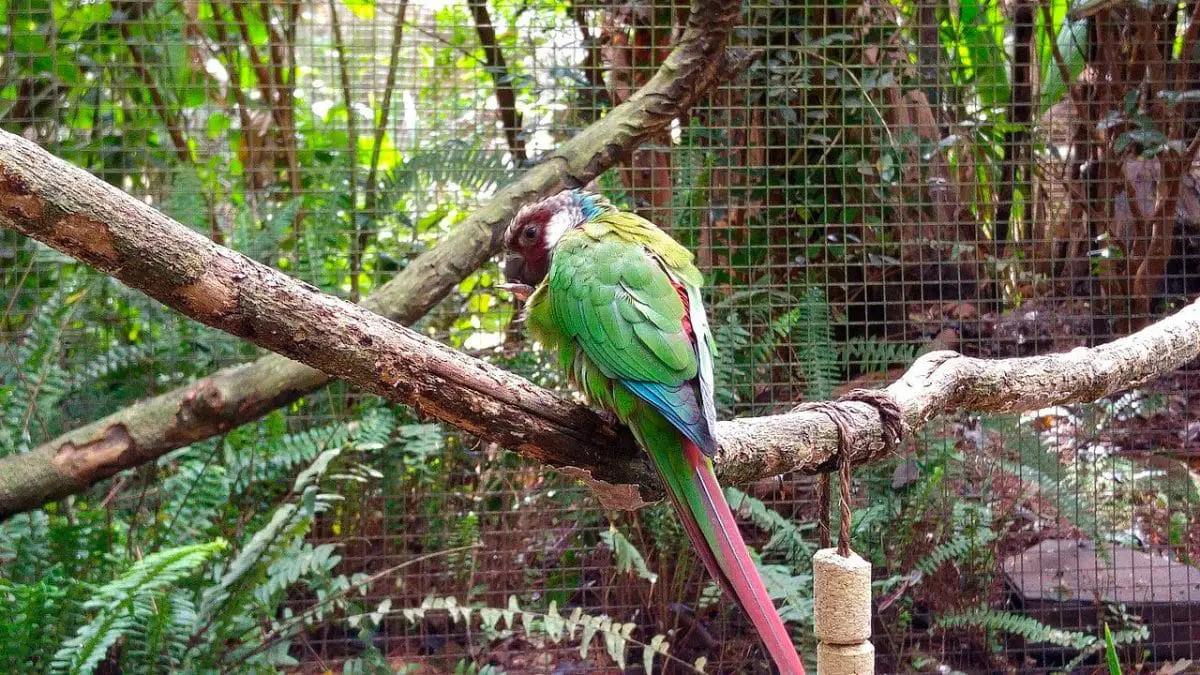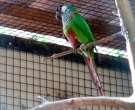Content |
|---|
Description:
The Maroon-faced Parakeet (Pyrrhura leucotis) measured 21 centimeters length and 50-53 g. of weight, It is the smallest species long-tailed parakeets.
Their cheeks and forecrown, They are brown brown mostly, blue above eyes and on lower cheeks; crown and nape, dark brown, dotted with orange-brown from the ends of pens; ear-coverts white to pale brown; nape with bluish green tones.
Mantle and top of the back, green with scattered dark margins on some feathers; lower back, rump and uppertail-coverts, brown. Wing coverts except green primary coverts which they are blue and patch Red in the bend of wing.
Primaries blue. Under, the wings with the lesser coverts green, the greater coverts dark gray; the flight feathers grey. Feathers of the throat and sides neck, blue base with a yellowish subterminal band and black tips; feathers of the chest with little blue tones and instead to brown in bases; the underparts They are green with a large patch brown in the center of belly. maroon brown with green edges at the base of the outerweb of the lateral feathers; undertail, the tail It is reddish brown opaque.
Bill black; cere black; bare periophthalmic grey; irises dark orange-brown; legs dark grey.
The plumage of both sexes are similar.
Taxonomic status:
Regarded as a subspecies Pyrrhura [leucotis or emma] by some authors
- Sound of the Maroon-faced Parakeet.
Habitat:
The Maroon-faced Parakeet inhabits forests, clear edges and adjacent with scattered trees including cocoa plantations shaded Bay, sometimes visiting parks and residential areas. They can be observed, mainly, in lowlands (for example, to 600 meters in east Brazil) and in forests at higher elevations in Northeast Brazil. gregarious, generally close to flocks 15-20 birds.
Reproduction:
No information about your reproduction in the wild. Clutch 5-9 eggs in captivity.
Food:
Probably you have a diet comparable to his close relatives in the wild, where is recorded the Miconia hypoleuca as one of their food. There are reports of birds feeding in cornfields.
Distribution:
Size of its range (players / residents): 352.000 km2
The distribution of the Maroon-faced Parakeet It is limited to Southeast Brazil, from Bay to the South of the Jequitinhonha river, to the South up to Espirito Santo, including Southeast Minas Gerais, Brazil, and previously São Paulo.
Conservation:
-
Justification of the Red List of the Category
– This species appears as Near-threatened on the basis that it is suspected that there has been a decrease in moderately rapid population due to the habitat loss and capture.
-
Justification of the population
• Current category of the Red List of the UICN: Near-threatened..
• Population trend: Decreasing.
• Population size : 10000-19999 individuals.
– The Maroon-faced Parakeet is believed to have a small town; However, Marsden et al .(2000) It estimated that there is a combined population of about 19,300 individuals on Biological Federal Reserve Sooretama the Nature Reserve Linhares in the State of Espirito Santo, based on surveys 1998, It is suggesting that the population has been previously underestimated.
– Until an updated estimate available, the population was provisionally placed in the band 10,000-19,999 mature individuals, representing a population of about 15,000-30,000 individuals in total, although the structure of the subpopulation not known.
-
Justification trend
State of conservation ⓘ |
||
|---|---|---|
 Near Threatened ⓘ (UICN)ⓘ
Near Threatened ⓘ (UICN)ⓘ
| ||
– It is suspected that the species is in a moderate to rapid decline due to the habitat loss and capture. The rate of decline is not thought to be as rapid because the tolerance of this species to modified habitats buffers the impacts of deforestation to some extent..
-
Threats
– The logging It has been extensive, It is affecting most of board woods, in Bay and Espirito Santo.
– Most of the original forest cover in which the Maroon-faced Parakeet It was eliminated more than a century ago; in the news, are being eliminated very quickly the remaining patches (pit et to the ., 1997).
– This bird often seized in captivity, suggesting that there is a major catch birds for trade. (J. Gilardi in little ., 2010).
"Maroon-faced Parakeet" in captivity:
Very rare.
Its diet in captivity it is similar to that of their peers.
Its population in the wild is small and decreasing whereby each captive specimen of this species that is capable of reproducing, must be placed in a well-managed captive breeding program and not sold as a pet, in order to ensure its long-term survival.
Alternative names:
– Maroon-faced Parakeet, Maroon-faced Parakeet (White-eared), White-eared Parakeet (English).
– Conure emma, Conure leucotique, Conure leucotique (nominal), Conure leucotique (nominale), Conure leucotique (race nominale) (French).
– Weißohrsittich (German).
– tiriba-de-orelha-branca (Portuguese).
– Cotorra orejiblanca, Perico Pintado, Cotorra cariparda (español).
scientific classification:

– Order: Psittaciformes
– Family: Psittacidae
– Genus: Pyrrhura
– Scientific name: Pyrrhura leucotis
– Citation: (Kuhl, 1820)
– Protonimo: Psittacus leucotis
Images Maroon-faced Parakeet:
Videos "Maroon-faced Parakeet"
Maroon-faced Parakeet (Pyrrhura leucotis)
Sources:
– Avibase
– Parrots of the World – Forshaw Joseph M
– Parrots A Guide to the Parrots of the World – Tony Juniper & Mike Parr
– Birdlife
– Photos:
(1) – Maroon-faced parakeet By Gabriel Resende Veiga (Own work) [CC BY-SA 4.0], via Wikimedia Commons
(2) – Several White-eared Parakeets (Pyrrhura_leucotis) at Palmitos Park, Gran Canaria, Spain By Bjoertvedt (Own work) [CC BY-SA 3.0 or GFDL], via Wikimedia Commons
(3) – A White-eared Parakeet in Parque das Aves, Foz do Iguaçu, Brazil By Kee Yip from Union City, California, USA (IMG_4336_P1030859Uploaded by snowmanradio) [CC BY 2.0], via Wikimedia Commons
(4) – White-eared Parakeet (Pyrrhura leucotis), Vale Reserve, Holy Spirit, Brazil by Brendan Ryan – Flickr
(5) – By Almond Butterscotch – Flickr
(6) – Parrots in captivity /. London :George Bell and Sons,1884-1887 [i.e. 1883-1888] by Biodiversity Heritage Library – Flickr
– Sounds: Roney Souza, XC265102. accessible www.xeno-canto.org/265102






